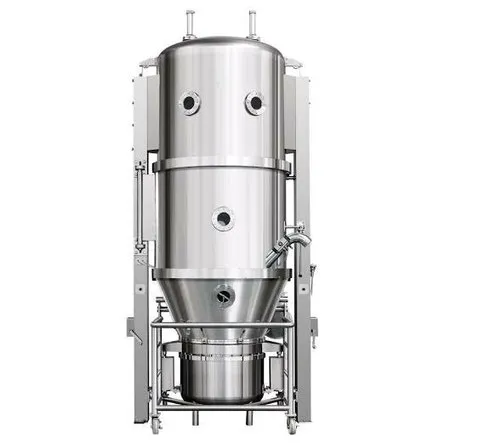A fluid bed dryer is an essential piece of equipment in industries such as pharmaceuticals, food processing, chemicals, and agriculture. It is widely used for drying powders, granules, and other particulate materials. The efficiency, uniform drying, and reduced processing time make the fluid bed dryer an ideal choice for many applications. In this article, we will delve into the design and working principle of a fluid bed dryer, exploring its components, operational mechanisms, advantages, and applications.
Design of a Fluid Bed Dryer
The design of a fluid bed dryer is carefully engineered to ensure optimal drying performance. It consists of several key components that work together to create the fluidization effect necessary for efficient drying. The primary elements include:
- Air Handling System: The air handling unit comprises a blower, heater, and filter. It generates and controls the flow of hot air, which is essential for fluidizing the material.
- Product Container (Drying Chamber): This is the main section where the material is loaded for drying. The chamber is designed to allow uniform airflow and prevent material loss.
- Perforated Distributor Plate: Located at the bottom of the drying chamber, this plate ensures the even distribution of air, helping to maintain a consistent fluidized state of the material.
- Exhaust System: The exhaust system removes moisture-laden air from the drying chamber. It may include cyclones, bag filters, or scrubbers to capture fine particles and prevent environmental contamination.
- Control Panel: A fluid bed dryer is equipped with a control system that regulates temperature, airflow, and drying time to achieve the desired moisture content in the material.
The size and configuration of a fluid bed dryer depend on the application and the type of material being processed. Batch and continuous fluid bed dryers are the two main configurations, each with specific advantages.
Working Principle of a Fluid Bed Dryer
The working principle of a Fluid bed dryer is based on the concept of fluidization. Fluidization occurs when a gas (usually heated air) is passed through a bed of solid particles at a velocity sufficient to lift and suspend them, creating a fluid-like behavior. This enhances heat and mass transfer, leading to rapid and uniform drying.
The drying process in a fluid bed dryer follows these steps:
- Air Preheating: The air handling system draws ambient air, filters it to remove impurities, and heats it to the required drying temperature.
- Fluidization of Material: The heated air is introduced through the perforated distributor plate at the bottom of the drying chamber. The upward airflow lifts the material, causing it to behave like a fluid.
- Moisture Removal: As the hot air interacts with the fluidized particles, moisture evaporates from the material. The continuous circulation of air ensures uniform drying and prevents overheating or degradation of the product.
- Exhaust and Recovery: The moisture-laden air exits through the exhaust system, which may include filters or scrubbers to capture fine particles and minimize emissions.
- Product Discharge: Once the desired moisture level is achieved, the dried material is discharged for further processing or packaging.
Advantages of a Fluid Bed Dryer
The fluid bed dryer offers several advantages over traditional drying methods such as tray drying or rotary drying. Some of the key benefits include:
- Faster Drying Time: The fluidization process ensures efficient heat transfer, significantly reducing drying time.
- Uniform Drying: The movement of particles in the fluidized state ensures even exposure to heat, preventing localized overheating.
- Energy Efficiency: The efficient heat and mass transfer mechanisms lead to lower energy consumption compared to other drying methods.
- Scalability: Fluid bed dryers are available in various sizes, making them suitable for both small-scale and large-scale production.
- Better Product Quality: The controlled drying process preserves the physical and chemical properties of sensitive materials, such as pharmaceuticals and food products.
- Easy to Clean and Maintain: The simple design and modular construction allow for easy cleaning and maintenance, reducing downtime in production.
Applications of a Fluid Bed Dryer
Fluid bed dryers are widely used across different industries due to their efficiency and versatility. Some common applications include:
- Pharmaceutical Industry: Used for drying granules and powders in tablet manufacturing, ensuring consistent moisture levels for compression.
- Food Processing: Applied in drying food ingredients such as milk powder, coffee, and spices, preserving their flavor and nutritional value.
- Chemical Industry: Utilized for drying various chemical powders and granules, improving handling and storage stability.
- Agricultural Sector: Used for drying seeds, grains, and animal feed, enhancing shelf life and reducing microbial growth.
Challenges and Considerations
While the fluid bed dryer is highly effective, there are some challenges and considerations to keep in mind:
- Particle Size Limitations: Very fine or cohesive powders may cause agglomeration, affecting fluidization efficiency.
- Temperature Sensitivity: Some heat-sensitive materials require precise temperature control to prevent degradation.
- Initial Investment Cost: The upfront cost of a fluid bed dryer can be high, but the operational efficiency often offsets the investment over time.
- Environmental Considerations: Proper exhaust filtration systems are needed to prevent the release of fine particles into the environment.
Conclusion
A fluid bed dryer is a crucial piece of equipment for efficient and uniform drying in various industries. Its design ensures optimal airflow, fluidization, and moisture removal, resulting in faster drying times and better product quality. The working principle, based on fluidization, enhances heat and mass transfer, making it a preferred drying method for pharmaceuticals, food, chemicals, and agricultural products. Despite some challenges, the advantages of a fluid bed dryer outweigh the drawbacks, making it a valuable investment for businesses that require effective drying solutions. Understanding the design and working principle of a fluid bed dryer can help industries optimize their drying processes and improve overall productivity.
